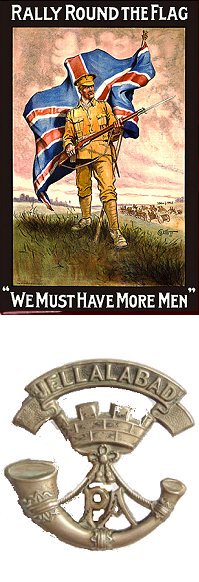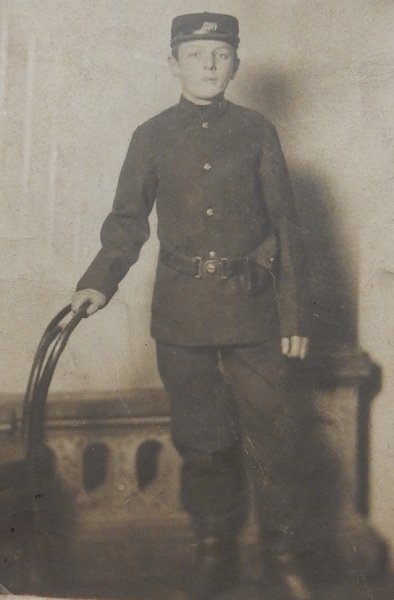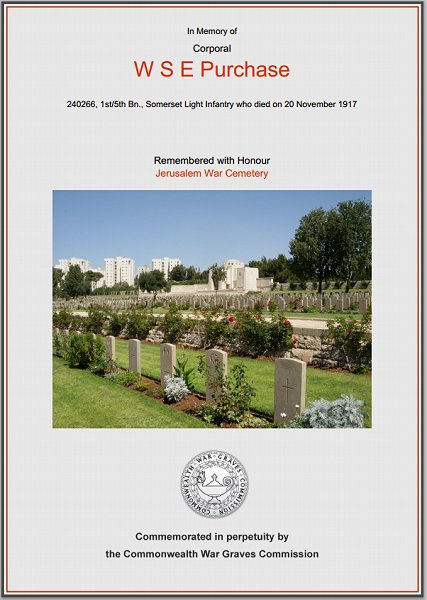yeovil at War
Wilfred Stanley Edwin Purchase
Died while in the Egyptian Expeditionary Force
Wilfred Stanley Edwin Purchase, known as Stanley, was born in Yeovil in 1896, the elder son of carpenter Edwin Purchase (b 1872) and Mary née Beare (b 1872), both of Yeovil. Around 1900 Edwin and Mary had moved from Yeovil (where both of their sons were born) to London and by 1901 were living in Fulham with four-year old Stanley and his two-year old brother John Alfred Leonard, known simply as Leonard. By 1911 the family, now with a daughter Gladys, were living at 6 Gray Street, off Manchester Square, Marylebone. Stanley, now aged 14, worked as a Post Office messenger.
 As
soon as war
broke out in
1914, 17-year
old Stanley
returned to
Yeovil where he
enlisted in the
Army and became
Private (Service
No 240266) in
1st/5th
Battalion,
Somerset Light
Infantry. He was
to serve
throughout the
war with the
Battalion.
As
soon as war
broke out in
1914, 17-year
old Stanley
returned to
Yeovil where he
enlisted in the
Army and became
Private (Service
No 240266) in
1st/5th
Battalion,
Somerset Light
Infantry. He was
to serve
throughout the
war with the
Battalion.
The 1st/5th Battalion was a Territorial Battalion formed on 4 August 1914 at the County Territorial Hall, Taunton as part of the South-Western Brigade, Wessex Division. It was initially stationed at Plymouth for a few days and then proceeded to Salisbury Plain. On 9 October 1914 the Battalion sailed from Southampton and arrived at Bombay, India, on 9 November 1914.
The battalion remained at Jubbulpore until December, when it proceeded to Ambala. Strenuous training began almost immediately and continued almost for the next year. In May 1916 a large draft of nine officers and 449 other ranks arrived from England and the battalion was temporarily divided during the ensuing hot weather with some companies going to Chakrata and the remainder to Meerut.
The following months were mainly occupied in training the draft but even in the hills little was done beyond this owing to the exceptionally wet season. The Battalion was reunited in October at Meerut. On 26 April 1917 17 officers and 838 other ranks of the Battalion sailed on HMT Chakdara from Bombay, landing at Suez, Egypt, on 11 May 1917, becoming part of 233rd Brigade, 75th Division - part of the Egyptian Expeditionary Force in Palestine.
Having spent an uneventful two and a half years in India it was now intended that the 1st/5th Battalion was to become involved in the attack on Gaza which had been ordered to take place on the morning of 2 November 1917 although 1st/5th Battalion of the Somerset Light Infantry were ultimately not employed in the attack.
The Regimental History of the Somerset Light Infantry records "Several weeks training at El Arish and Rafa, where long route marches through the burning desert fitted the Battalion for the part it was to play in the near future.... The remainder of September was uneventful.
For a series of postcards sent home by Stanley during this period - click here.
The Action of El Mughar, also known as the Battle of Mughar Ridge, took place on 13 November 1917 during the Pursuit phase of the Southern Palestine Offensive of the Sinai and Palestine Campaign. Fighting between the advancing Egyptian Expeditionary Force (EEF) and the retreating Yildirim Army Group, occurred after the Battle of Beersheba and the Third Battle of Gaza. Operations occurred over an extensive area north of the Gaza to Beersheba line and west of the road from Beersheba to Jerusalem via Hebron. Strong Ottoman Army positions from Gaza to the foothills of the Judean Hills had successfully held out against Allied forces for a week after the Ottoman army was defeated at Beersheba. But the next day, 8 November, the main Ottoman base at Sheria was captured after two days' fighting and Turkish units along the whole line were in retreat. The Allies attacked the Ottoman Eighth Army on an extended front from the Judean foothills across the Mediterranean coastal plain from 10 to 14 November.
The Regimental History of the Somerset Light Infantry records the detail of the Action of El Mughar and the part played in it by the 1st/5th Somersets, including Stanley Purchase - "On the 12th the Battalion moved forward and occupied a ridge south of El Kustineh and El Turmus, digging in and remaining in the position during the night of 12th/13th. The task allotted to the 233rd Infantry Brigade in the attack to take place on the 13th November was the capture of Tel El Turmus - El Kustineh (both inclusive) with El Mesmiyeh as a further objective.
In phase one the 1/5th Somersets were to attack Tel El Turmus, and the 1/4th Wilts Regt. Kustineh, both Battalions attacking El Mesmiyeh as a further objective.... At dawn on the 13th the Brigade was ready formed up for the attack, the 1/5th Somersets on the right and the 1/4th Wilts on the left, with the 3/3rd Gurkhas guarding the left of the Brigade and the 2/4th Hants in Brigade Reserve. The Somersets disposed No 1 and No 4 Companies in the front line with No 3 in support and No 2 in reserve.
By 6:50am patrols of the Somersets and Wilts had reported Turmus and Kustineh clear of the enemy, and at 8am the leading waves of both Battalions advanced to occupy the two villages and re-form north-east of the latter ready for the attack on El Mesmiyeh. In moving through Turmus the 1/5th came under shell fire, but no casualties resulted and by 9:15am the Battalion had formed up north-east of the village, as ordered, ready for the next phase of the attack. Kustineh had similarly fallen into the hands of the Wilts Regt., the latter forming up for the next stage of the operations on the left of the Somerset men. Of the latter Battalion No 3 and No 2 Companies now formed the front line with No 1 in support and No 4 in reserve.
At 10:15am the attack on El Mesmiyeh began. About 1,200 yards from the village the 1/5th Somersets first came under very heavy shell fire and ultimately, as the Battalion approached its objective, violent rifle and machine-gun fire principally from the right flank. But with great steadiness the Somerset men kept on and El Mesmiyeh was stormed and captured "with great dash and gallantry". The village had fallen by 10:55am, but it took another half hour to clear the cactus-hedges and gardens of Turkish snipers who had concealed themselves cleverly. But eventually the last remaining Turk had either been shot down or sent scuttling back to the main body of the enemy, who had taken up position on the ridge running approximately east and west, about 1,000 - 1,200 yards north of El Mesmiyeh. A counter-attack on the latter was beaten off, but the Turkish guns continued to shell the village heavily while the enemy's rifle and machine-gun bullets tore through the cactus hedges behind which the British troops were lying awaiting further orders. The 3/3rd Gurkhas were now moved up into the village to strengthen the position.
At 3:45pm Brigade Headquarters ordered the 1/5th Somersets and 1/4 Wilts to attack and occupy the ridge north of El Mesmiyeh. For this attack No 3 and No 1 Companies of the 1/5th Somersets were lent to the Wilts.... This attack was again completely successful, the Somerset men and the Wilts attacking the ridge with great determination. They dislodged the enemy who fled in full retreat, the Somerset men capturing three machine guns after killing practically all the crews of the guns. The Wilts took many prisoners. No 2 and No 4 Companies of the Somersets guarded the right flank of the attack which was still under heavy machine-gun fire."
Casualties suffered by the 1st/5th Battalion of the Somerset Light Infantry during the fighting on 13 November 1917 were one officer and five other ranks killed and two officers and 41 other ranks wounded.
Following the battle, the 1st/5th Somersets, together with the rest of the Brigade, concentrated on the Jerusalem Road and moved forward. At dawn on 20 November the advance began on Kuryat el Enab. The Regimental History described the attack thus "The attack on Enab was carried out by the 1/5th Somersets in front, the 1/4th Wilts in echelon in left rear, with 3/3rd Gurkhas on the left of the Wiltshires. The formation of the Somersets in this attack was No 2 and No 4 Companies in the front line, No 3 in support and No 1 in reserve. There was heavy driving rain as the troops moved forward and mist covered the battlefield, but with great dash the attacking waves advanced and completely drove the Turks from their positions in front of Enab. Getting in with the bayonet the Somerset men, though met by heavy machine-gun and rifle fire, were not to be denied and brilliantly carried first the defences in front of Enab and then the village at a loss of only two other ranks killed and nine wounded.... For two hours during the early morning of 21st the village of Enab was shelled heavily by the Turks and, owing to the congested state of the village - packed with troops and animals - casualties were heavy."
Wilfred 'Stanley' Purchase was killed in this action on 20 November 1917, aged 21. Other Yeovil men killed in this battle were Frederick Wickstead, Harry Holland, Frederick Barnes, Thomas Luxton and Edward Bell.
Stanley was interred in Jerusalem War Cemetery, Israel, (Grave P.12). His name is recorded (as Wilfred) in the County of Somerset Book of Remembrance in St Martin’s Chapel, Wells Cathedral and is inscribed on the War Memorial in the Borough.
gallery

Courtesy of
Dinah Cheek
Edwin Purchase and Mary née Beare with their children (Stanley is seated at left) photographed by John Chaffin & Sons, probably in their Hendford studio around 1900.

Courtesy of
Dinah Cheek
Stanley Purchase in his Post Office Messenger uniform, aged 14 in 1911.

Courtesy of
Dinah Cheek
Stanley in tropical kit, almost certainly photographed in India as there was not likely to have been time in the Gaza Campaign.

Courtesy of
Dinah Cheek
The commemorative scroll sent to Stanley's family.

The Commonwealth War Graves Commission certificate in memory of Wilfred 'Stanley' Purchase

Courtesy of
Dinah Cheek
Stanley Purchase's headstone in the Jerusalem War Cemetery.